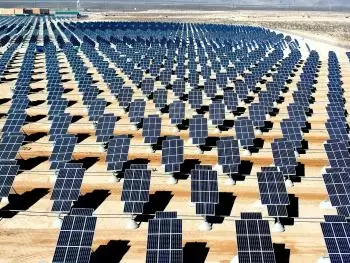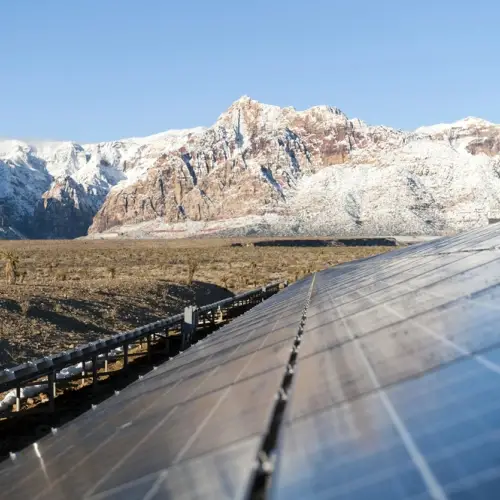
A solar photovoltaic (PV) power plant is an innovative energy solution that converts sunlight into electricity using the photovoltaic effect. This process occurs when photons from sunlight strike a material, typically silicon, and displace electrons, generating a direct current (DC).
The acronym "PV" is widely used to represent "photovoltaics," a key technology in renewable energy.
A photovoltaic plant is made up of PV modules and an inverter. Photovoltaic panels are responsible for transforming solar radiation. In turn, the inverter converts direct current into alternating current with characteristics similar to the electrical grid.
A solar array is a collection of multiple solar panels that generate electricity as a system. In a solar array, all the electricity generated is injected into the electrical distribution network. In this way, the performance is better because all the energy generated is used.
The largest solar PV power plant in the world is the Bhadla Solar Park in India. It has an installed capacity of 2,245 MW. The total cost of the installation was 1200 million euros.
Photovoltaics (PV) is renewable energy and clean energy because it does not generate polluting gases.
Components of a Photovoltaic Power Plant
Solar PV power plants consist of several interconnected components, each playing a vital role in converting solar energy into usable electricity.
- Solar Modules:
Comprised of photovoltaic cells made of silicon, these panels capture sunlight and initiate the photovoltaic effect. Many systems employ solar trackers to follow the Sun's movement, maximizing efficiency. - Meteorological Tower:
Monitors climatic conditions like sunlight intensity, humidity, and temperature, which affect energy production.
Direct Current (DC) Cabinet:
Collects electricity generated by the PV cells and prepares it for conversion. - Inverter:
Converts the direct current (DC) into alternating current (AC), compatible with electrical grids. - Alternating Current (AC) Cabinet:
Receives the AC electricity and channels it for further processing. - Transformation Center:
Adjusts the electricity's voltage and intensity to meet transmission requirements. - Transportation Lines:
Facilitate the transfer of electricity to consumption centers or the grid. - Control Room:
Centralized hub where operators monitor and manage all systems in the plant.
How does a PV power plant work?
The operation of all the equipment in the plant is supervised from the control room. In addition, information is received from the tower, the inverter, the power cabinets, the transformation centers, etc.
The process to transform solar energy into electricity is as follows:
1.- Conversion of solar energy into direct current
Photovoltaic cells are the essential elements of a photovoltaic system. These are grouped in photovoltaic panels.
Solar cells capture the Sun’s radiation and convert it into electrical energy. In general, they are composed of silicon which is a semiconductor material that facilitates the photoelectric effect.
When a photon collides with a solar cell, an electron is released. With the sum of many free electrons, electricity is generated in the form of direct current.
The electricity generation capacity will depend on meteorology (radiation, humidity, temperature, etc.). Therefore, depending on the weather of each moment, the solar radiation that the photovoltaic cells will receive will be variable. For this reason, the tower is built in the solar plant.
2.- Transformation of direct current to alternating current
Photovoltaic panels generate direct current. However, the electrical energy that circulates through the transmission network does so in alternating current. For this reason, direct current (DC) must be transformed to alternating current (AC).
First, the direct current from the solar panels is led to a direct current cabinet. In this cabinet, the current is molded into alternating current through a current inverter. The electricity is then sent to an alternating current cabinet.
3.- Transport and supply of electricity
The current that reaches the AC cabinet is not yet ready to be supplied to the electricity grid.
For this reason, the electrical energy produced passes through a transformation center. This center adapts the intensity and voltage to be the best conditions for the transmission lines.
Large PV plants face the additional challenge of needing to achieve favorable grid connections.
Types of photovoltaic plants
 There are several types of photovoltaic plants, which vary according to their size, configuration and application. Here are some of the most common types:
There are several types of photovoltaic plants, which vary according to their size, configuration and application. Here are some of the most common types:
-
Large-Scale Photovoltaic Power Plants: These are large solar power generation facilities designed to produce a significant amount of electricity. They can occupy large areas, such as solar parks on the ground or on elevated structures. These plants typically have a capacity of several megawatts (MW) or even gigawatts (GW).
-
Floating photovoltaic plants: These plants are installed on bodies of water, such as reservoirs, lakes or ponds. Photovoltaic panels float on the surface of the water, which helps reduce water evaporation and improves the efficiency of the panels due to the natural cooling provided by the water.
-
Rooftop photovoltaic plants: This type of installation involves the placement of photovoltaic panels on the roofs of residential, commercial or industrial buildings. These installations can be on a small or medium scale, and are usually intended to supply energy directly to the buildings themselves.
-
Distributed photovoltaic systems: These systems are made up of multiple photovoltaic panels installed in homes, businesses or smaller industrial facilities. The electricity generated is used to meet the energy demand in the place where the installation is located, and the excess energy can be injected into the electrical network.
-
Solar Tracking Plants: These plants use solar tracking systems to automatically adjust the orientation of the panels throughout the day to follow the path of the sun. This allows a greater capture of sunlight and, consequently, a greater production of electricity compared to fixed systems.
-
Hybrid photovoltaic systems: These systems combine photovoltaic panels with other energy sources, such as wind turbines or diesel generators. The integration of various sources allows for a more stable and reliable supply of electricity, especially in places where the availability of sun can vary or be limited.
The 5 largest solar plants in the world
Below is a table with the five most important photovoltaic plants in the world:
|
No. |
Plant Name |
Location |
Capacity (MW) |
|
1 |
Bhadla, Rajasthan, India |
2,245 |
|
|
2 |
Parque Solar Tengger Desert |
Mongolia Interior, China |
1,547 |
|
3 |
Pavada Solar Park |
Pavagada, Karnataka, India |
2,050 |
|
4 |
Parque Solar Noor Abu Dhabi |
Abu Dhabi, United Arab Emirates |
1,177 |
|
5 |
Parque Solar Kurnool |
Kurnool, Andhra Pradesh, India |
1,000 |
Impact and Affectation on the Environment
Photovoltaic plants are a form of renewable energy generation that generally has a lower environmental impact than power plants based on fossil fuels.
However, they are not completely impact-free and can affect the environment differently. Here are some things to consider:
-
Land use: Large-scale plants require a considerable amount of space to house the solar panels. The installation of these plants may imply deforestation or the alteration of natural habitats, which may have an impact on local biodiversity.
-
Water use: Some cooling systems may require water to maintain the efficiency of the solar panels.
-
Manufacturing and materials: The production of photovoltaic panels requires the use of materials and energy, and their manufacture can generate emissions of greenhouse gases and other pollutants. Also, some materials used in the panels, such as silicon, come from minerals that require intensive extraction processes.
-
Waste and Recycling: Solar panels have a limited lifespan, and at the end of their useful life, they can become electronic waste.
-
Impact on fauna: Some photovoltaic installations, especially large installations on the ground, modify the landscape and vegetation, which can pose risks for local fauna.
Comparison with other power plant technologies
Here’s a comparative analysis of solar photovoltaic (PV) power plants with other major power station technologies, focusing on efficiency, environmental impact, costs, and scalability.
Efficiency
| Technology | Efficiency (%) | Remarks |
|---|---|---|
| Solar PV | 15–25% | Efficiency depends on panel type, location, and weather. |
| Nuclear Power | 33–37% | High efficiency, but limited by thermodynamic and safety constraints. |
| Coal Power | 33–40% | Efficiency depends on plant design (e.g., supercritical boilers). |
| Natural Gas | 45–60% | Combined-cycle plants achieve the highest thermal efficiency. |
| Wind Power | 30–45% | Efficiency varies with wind availability and turbine design. |
| Hydropower | 85–90% | Among the most efficient due to direct conversion of water's kinetic energy. |
Environmental Impact
| Technology | Environmental Impact |
|---|---|
| Solar PV | Minimal greenhouse gas emissions during operation. Land use and material production can affect ecosystems. |
| Nuclear Power | No direct emissions, but waste management and potential radiation risks are significant concerns. |
| Coal Power | High emissions of CO₂, SO₂, and particulate matter. Significant contributor to global warming and air pollution. |
| Natural Gas | Lower emissions than coal, but methane leakage during extraction is problematic. |
| Wind Power | Clean and renewable, but can impact bird populations and aesthetics. |
| Hydropower | No emissions during operation, but dam construction can disrupt ecosystems and displace communities. |
Cost Analysis
| Technology | Levelized Cost of Energy (LCOE) | Remarks |
|---|---|---|
| Solar PV | $30–60 per MWh | Costs continue to decline due to advancements in technology and scaling. |
| Nuclear Power | $90–130 per MWh | High initial investment; costs rise due to long construction timelines. |
| Coal Power | $50–120 per MWh | Cheaper upfront, but carbon pricing could make it less competitive. |
| Natural Gas | $40–70 per MWh | Competitive, especially for peaking power. Prices fluctuate with gas markets. |
| Wind Power | $30–50 per MWh | Offshore wind is more expensive than onshore. |
| Hydropower | $40–90 per MWh | Reliable and long-lasting, but high initial infrastructure costs. |
Scalability and Deployment
| Technology | Scalability | Deployment Speed |
|---|---|---|
| Solar PV | High | Quick to install, modular, and suitable for diverse scales. |
| Nuclear Power | Low | Long planning and construction timelines. |
| Coal Power | Moderate | Requires extensive infrastructure and fuel supply chains. |
| Natural Gas | Moderate | Flexible deployment; suitable for varying demand. |
| Wind Power | High | Onshore wind farms are faster to deploy than offshore. |
| Hydropower | Low | Limited by geographical and ecological constraints. |
Reliability
| Technology | Reliability |
|---|---|
| Solar PV | Intermittent; dependent on sunlight. Requires storage or grid integration for stability. |
| Nuclear Power | Highly reliable; provides constant base-load power. |
| Coal Power | Reliable, but heavily polluting. |
| Natural Gas | Reliable and can quickly ramp up/down to meet demand. |
| Wind Power | Intermittent; dependent on wind availability. |
| Hydropower | Highly reliable; excellent for base-load and peak-load power. |
Advantages and Challenges
| Technology | Advantages | Challenges |
|---|---|---|
| Solar PV | Renewable, scalable, rapidly declining costs | Weather-dependent; land and material requirements |
| Nuclear Power | No direct emissions, high energy density | High costs, long timelines, and radioactive waste |
| Coal Power | Abundant and established infrastructure | High pollution and environmental impact |
| Natural Gas | Cleaner than coal, flexible generation | Greenhouse gas emissions and market volatility |
| Wind Power | Renewable, low emissions | Intermittent, location-specific |
| Hydropower | High efficiency, long lifespan | Environmental disruption and high initial costs |